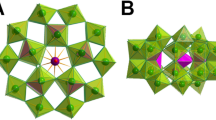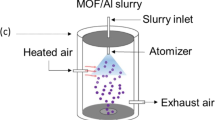Abstract
The mesoporous inorganic–organic SiO2–TiO2–PEG hybrid resin systems with various useful functionalities were directly synthesized by a binary sol–gel reaction of TEOS–TiCl4 and the subsequent chelation with a chatecholic compound (dihydroxy benzene), dihydroxy-m-benzenedisulfonic acid disodium salt, on the surface Ti ion of the ordered mesoporous SBA-15 network structure, respectively. Moreover, the hybrid resins consisting of polyethylene glycol and a silane coupling agent exhibited the controlled wettability, excellent coating processibility on various substrates with strong abrasion resistance. Furthermore, the transparent and low viscous resin showed the successful performance to fabricate various nanoscale patterns with the feature size down to 170 nm by imprint lithography. Based on the excellent patternability, nanofluidics with 100 nm of the narrowest dimension channel height was fabricated to employ a capillary electrophoresis for separation DNAs without gel matrix. In addition, the presence of sulfonic acid in the resin also showed the solid acid catalytic performance. These results reveal that the developed hybrid materials are very useful as an imprint resin as well as versatile microchemical applications.







Similar content being viewed by others
References
Sun T-L, Wang G-J, Feng L, Liu B-Q, Ma Y-M, Jiang L, Zhu D-B (2004) Angew Chem Int Ed 43:357
Ren D, Cui X, Shen J, Zhang Q, Yang X, Zhang Z, Ming L (2004) J Sol–Gel Sci Technol 29:131
Cebeci F-C, Wu Z, Zhai L, Cohen R-E, Rubner M-F (2006) Langmuir 22:2856
Ratner B-D, Schoen F-J, Hoffman A-S, Lemons J-E (2004) Biomaterials science, An introduction to materials in medicine. Elsevier, New York
Kim P-N, Lee B-K, Lee H-Y, Kawai T, Suh K-Y (2008) Adv Mater 20:31
Yu X, Zhang D, Li T, Hao L, Li X (2008) Sensors Actuator A 108:103
Zhang X, Haswell S-J (2006) MRS Bull 31:95
Kim P-N, Lee S-E, Jung H-S, Lee H-Y, Kawai T, Suh K-Y (2006) Lab Chip 6:54
Berdichevsky Y, Khandurian J, Guttman A, Lo Y-H (2003) Sensors Actuator B 97:402
Langroudi A-E, Mai C, Vigier G, Vassoille R (1997) J Appl Polym Sci 65:2387
Watts P, Haswell S-J (2005) Chem Eng Technol 28:290
Lee B-K, Hong L-Y, Lee H-Y, Kim D-P, Kawai T (2009) Langmuir 25:11768
Belin S, Santos L-R-B, Briois V, Lusvardi A, Santilli C-V, Pulcinelli S-H, Chartier T, Larbot A (2003) Colloid Surf A Physicochem Eng Asp 216:195
Hong L-Y, Cho Y-S, Kim D-P (2005) J Ind Eng Chem 11:275
Li C, Wilkes G-L (2001) Chem Mater 13:3663
Zhao D, Feng J, Huo Q, Melosh N, Fredrickson G-H, Chmelka B-F, Stucky G-D (1998) Science 279:548
Guan K, Lu B, Yin Y (2003) Surf Coat Technol 173:219
Pagnoux C (2002) J Ceram Process Res 3:10
Angelome P-C, Soler-Illia G (2005) Chem Mater 17:322
Yang Q, Kapoor M-P, Inagaki S, Shirokura N, Kondo J-N, Domen K (2005) J Mol Catal A Chem 230:85
Acknowledgment
This work was supported by the Korea Research Foundation Grant funded by the Korean Government(MOEHRD)” (KRF-2008-532-D0001).
Author information
Authors and Affiliations
Corresponding author
Additional information
L.Y. Hong, T.H. Yoon and H.I. Ryoo contributed equally to this work.
Electronic supplementary material
Below is the link to the electronic supplementary material.
Rights and permissions
About this article
Cite this article
Hong, LY., Yoon, TH., Ryoo, HI. et al. Functional SiO2–TiO2–PEG hybrid resin by direct chelation with catecholic compound. J Sol-Gel Sci Technol 57, 279–286 (2011). https://doi.org/10.1007/s10971-010-2181-1
Received:
Accepted:
Published:
Issue Date:
DOI: https://doi.org/10.1007/s10971-010-2181-1




